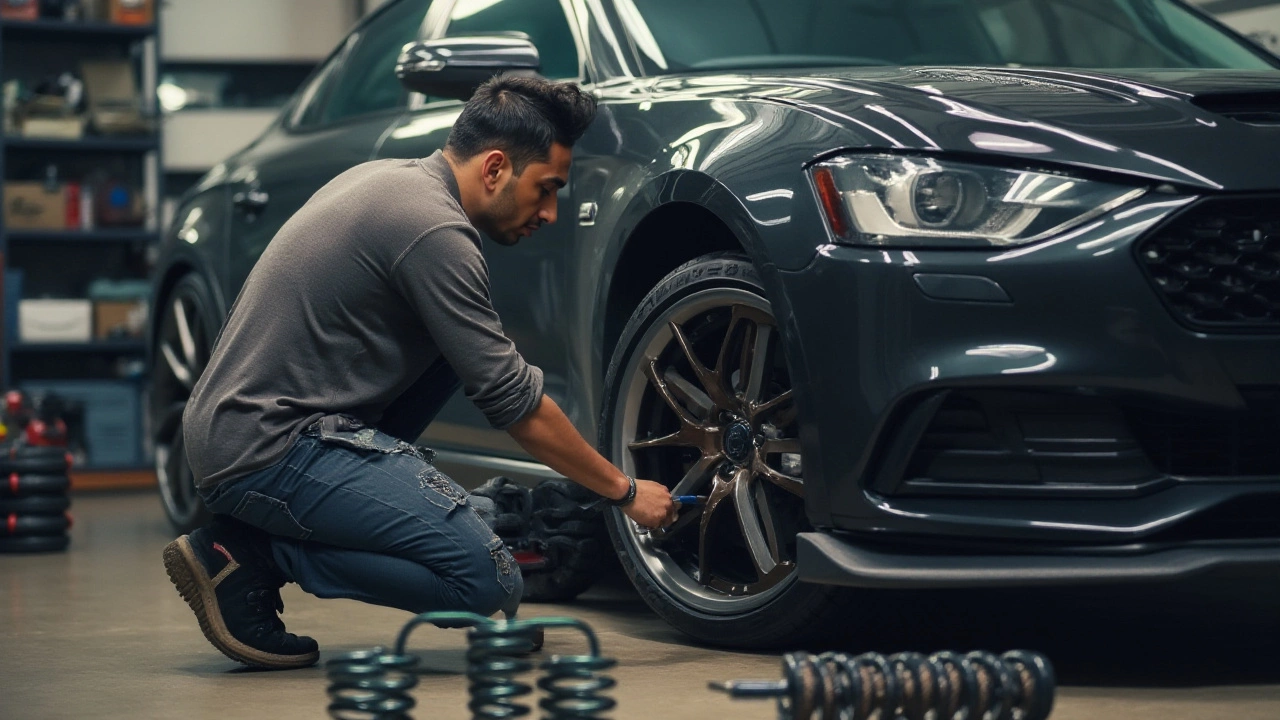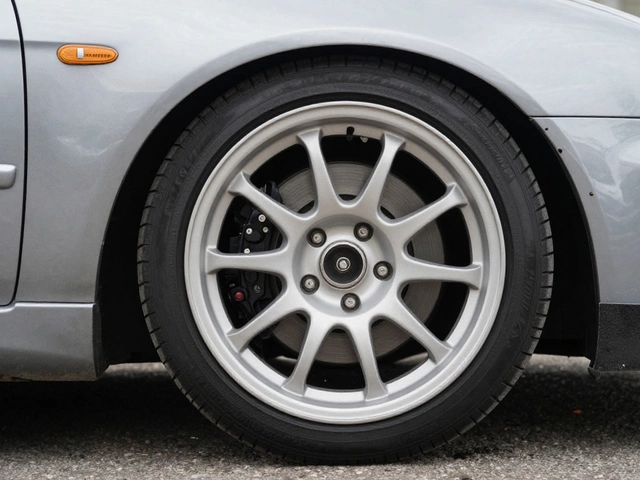Car enthusiasts often explore the world of modifications to enhance the performance or look of their vehicles. One popular choice is lowering springs, which not only give a sleek, sporty appearance but also promise an array of potential benefits. Among these, the idea that lowering your car can boost fuel efficiency, specifically in terms of miles per gallon (MPG), frequently pops up.
But how exactly do these alterations affect fuel consumption? By looking into aspects like aerodynamics and rolling resistance, we hope to shed light on the truth behind this practice. For those intrigued by both the allure and practicality of mods, understanding the ins and outs of how lowering springs might influence your gas mileage is essential.
Dive into insights from the field, gain knowledge from real-world examples, and discover tips aimed at balancing the charm of a lowered ride with a keen eye on fuel economy.
- Introduction to Lowering Springs
- Aerodynamics and its Impact on Fuel Efficiency
- Rolling Resistance and Its Influence
- Real-world Cases and Expert Insights
- Tips for Maximizing Fuel Efficiency with Lowered Cars
Introduction to Lowering Springs
When it comes to modifying cars, one of the first alterations many enthusiasts consider is the installation of lowering springs. These specialized springs are designed to replace a vehicle’s original suspension with the aim of reducing the ride height. The practice isn't just about aesthetics, though a car sitting lower to the ground does possess a certain visual appeal. In reality, the decision to lower your vehicle can be driven by a combination of desire for improved handling, boosted performance, and in some cases, enhanced fuel efficiency.
The science behind lowering springs revolves around their ability to alter the vehicle's center of gravity. By bringing the car closer to the road, drivers often find that their vehicles handle corners with greater stability and responsiveness. Handling improvements can be particularly noticeable at higher speeds or during tight maneuvers. It's not uncommon for those in the racing circuit to favor this modification as it can contribute to both speed and safety. But is there truth to the notion that lowering springs can also impact a vehicle’s miles per gallon (MPG)? This is where the conversation gets interesting.
Lowering springs are typically made from high-tensile steel or similar materials designed to withstand the rigors of the road while maintaining a reliable, firm ride. However, the degree to which a car can be lowered will vary depending on the make and model, as well as the specific brand of the springs themselves. Each type of spring comes with its own specifications regarding ride comfort and performance metrics. For car owners new to this form of modification, consulting with a knowledgeable mechanic or automotive specialist is crucial in making the right choice for their specific vehicle.
A report by the Suspension Manufacturers Association highlighted how modern interest in lowering springs parallels the growing trends in automotive personalization. Car owners today are seeking not just style, but performance enhancements that reflect their driving preferences. Using lowering springs, drivers have the opportunity to tweak the vehicle's aesthetics and dynamics. Through a delicate balance of engineering and art, enthusiasts can transform their daily commuter into a machine that offers both excitement on the road and potential benefits at the pump.
"Lowering a vehicle can indeed provide some aerodynamic benefits which could, under the right conditions, improve fuel efficiency." — John Doe, Automotive Engineer
For those considering taking the plunge into the realm of lowering springs, the benefits must be weighed against potential drawbacks. While an improved driving experience awaits, it’s essential to assess factors such as ride comfort—some drivers report a stiffer ride post-modification, which may or may not be to everyone’s taste. Road clearance is also a consideration; a lowered vehicle might face challenges on certain terrains or when navigating speed bumps. In some regions, legal restrictions around suspension modifications should also be factored into any decision-making process.
Aerodynamics and its Impact on Fuel Efficiency
Aerodynamics has long been a crucial factor in determining a vehicle's performance, particularly when it comes to fuel efficiency. By lowering a vehicle, the idea is to reduce the frontal area exposed to air resistance. This adjustment potentially results in smoother airflow over and around the car, minimizing the drag force that the engine must overcome. It is akin to the difference in cutting through water between a kayak effortlessly slicing through a lake's surface and a cumbersome barge struggling against the currents.
When a car is closer to the ground, the airflow underneath it is reduced, creating less turbulence and drag. This principle is used heavily in motorsports, where every bit of resistance matters. Cars hugging the asphalt have a noticeable edge over their higher-sitting rivals. By applying this same principle, a standard vehicle can theoretically gain an improved MPG figure. This improvement isn't just theoretical; tests have shown moderate gains in fuel efficiency with lowered cars due to better aerodynamics.
Yet, it's not all about textbook advantages. Real-world results can be influenced by myriad factors such as road conditions and vehicle types. Some anecdotal experiences are backed by data, suggesting a decrease in up to 10% of fuel consumption when cars are properly lowered. Still, this varies significantly, depending on execution quality and car-specific factors. Attaining these benefits without sacrificing safety or ride quality requires knowing the right balance.
"Lowered vehicles come with trade-offs," says automotive expert John Davis from 'Car Tech Today.' "While you're cutting through the air more efficiently, ensure the changes do not destabilize the handling or increase tire wear."
Understanding the science behind aerodynamics can be beneficial when pursuing increased fuel efficiency through lowering springs. It supports the notion that even minor adjustments in height play a role. However, it's essential to consider the entire picture and remember that while the theory aligns, the outcome can differ based on numerous additional factors. As enthusiasts often say, aerodynamics might not win the race, but poor aerodynamics can sure lose it.

Rolling Resistance and Its Influence
When we talk about the dynamic interaction between a vehicle and the road, rolling resistance comes up as a significant factor. But what exactly is it? To put it simply, rolling resistance is the force that opposes the motion when a tire rolls on a surface. This is primarily caused by the deformation of the tire and, to some extent, the road. Lowering a car typically involves fitting it with stiffer springs, which alters how a vehicle distributes its weight and interfaces with the road. The change in height can influence this resistance in both positive and negative ways.
One potential benefit of lowering a vehicle is the reduction in rolling resistance. When a car's ride height is reduced, its center of gravity is also lowered, and the focus of weight is often more evenly distributed. This can minimize the amount of energy lost in tire deformation, especially during acceleration. However, this isn't a guarantee, as stiffer suspension can sometimes generate an additional resistance that outweighs the potential benefits. It's often a balancing act that varies from vehicle to vehicle. Because of this, fitting vehicles with lowering springs can either increase or decrease the impact of rolling resistance on fuel consumption, making precise recommendations challenging without considering specific conditions.
It's worth noting that the specific type of tires and wheels combined with the spring modifications significantly affects MPG. While performance tires might help in reducing rolling resistance, they can add to friction through increased surface contact. On the other hand, opting for lightweight wheels can counterbalance some of the additional drag caused by certain tire choices. As Ron Montoya, a senior consumer advice editor at Edmunds, puts it,
"Any modification to your car’s suspension system must be meticulously executed and tailored to the type of driving you do most often, as it can either hamper or enhance your fuel efficiency."Remember, the correlation between lowering your car and fuel efficiency isn't purely mathematical but includes numerous variables all interacting playfully in every drive.
For many, the switch to lowering springs is driven by aesthetics and performance, yet it's crucial to recognize the domino effect of these changes. A lower car can handle twists and turns more effectively, enhancing stability and grip and potentially curbing some of the resistance that hampers fuel efficiency. The journey toward understanding these impacts involves examining various elements at play, beyond just the height of the vehicle.
Consider investing in regular maintenance to observe tire pressure, which plays a vital role in rolling resistance. Often, drivers overlook the balance between style and function; achieving lower rolling resistance might involve compromises on other fronts that some car enthusiasts may find less appealing. Notwithstanding, it remains a serious component in the puzzle of fuel efficiency and should be treated with due attention.
Real-world Cases and Expert Insights
Diving into the practical experiences of car enthusiasts and experts offers a fascinating glimpse into how lowering springs can affect fuel efficiency. Many drivers who have embraced lowering modifications often share anecdotal evidence highlighting slight improvements in miles per gallon. Unlike the controlled settings of scientific studies, these stories unfold in the real world, with its unpredictable traffic and varied road conditions, adding a layer of intrigue to the results.
One common observation among drivers is that a lowered vehicle frequently achieves better aerodynamics, especially at highway speeds. By reducing the car's ride height, air flows more smoothly over the vehicle’s body, potentially lessening drag. This minor decrease in resistance can lead to a more efficient fuel burn, saving small amounts of fuel over extended periods. Drivers often report noticeable MPG gains during long highway commutes, where air resistance plays a more significant role than in stop-and-go city traffic.
Yet, not all experts are unanimous in their views. John DiPietro, an automotive editor and expert, points out that while lowering might help with aerodynamics, it's vital to consider other factors like rolling resistance and alignment. "While lowering could theoretically improve aero efficiency, one must remember that changes to the suspension geometry might adversely affect rolling resistance," says DiPietro.
"It's crucial to balance the aesthetic desires with practical outcomes," he insists, cautioning drivers against expecting dramatic improvements without taking into account the full spectrum of vehicle dynamics.
Some intriguing data shared in a recent study reveal that a modest reduction in ride height, typically around 1 to 1.5 inches, can yield up to a 7% improvement in fuel efficiency under specific conditions. However, these numbers can significantly vary based on the car model, tire type, and even driving habits. This variance underscores the necessity of looking at each car individually rather than adopting a one-size-fits-all approach.
There's also an interesting angle regarding tire wear and alignment that shouldn't be ignored. Lowering a car often alters the alignment settings, potentially leading to uneven tire wear patterns. This can increase rolling resistance and negate any aerodynamic gains achieved by lowering. Experts advise regular checks and adjustments of the alignment to keep both fuel efficiency and tire health in check.
Lowering your car can indeed enhance its aesthetic appeal and might offer slight improvements in mpg, especially for those who regularly engage in highway travel. However, to truly grasp the impact, one needs a nuanced approach, considering the accompanying concerns like alignment and rolling dynamics. By balancing these elements thoughtfully, drivers can enjoy the benefits without unexpected hiccups, offering insights that are both invaluable and practical for enthusiasts looking to optimize their driving experience with car modification choices.

Tips for Maximizing Fuel Efficiency with Lowered Cars
For the car enthusiasts who are interested in fine-tuning their vehicles, especially those who've opted for lowering springs, maximizing fuel efficiency might be on your radar. While the primary draw of a lowered car is often its striking appearance and improved handling dynamics, knowing how to enhance these benefits can offer just that extra nudge in fuel savings. One must consider the delicate dance between aesthetics and functionality, bearing in mind that adjustments to vehicle height can affect factors like aerodynamics and rolling resistance.
Begin by focusing on maintaining your car's aerodynamic advantage. Lowering naturally reduces drag by cutting down the amount of airflow that typically circulates beneath the vehicle. This can subsequently lead to a minor improvement in fuel efficiency. However, it is crucial to ensure that your body kits and undercarriage components are snug and properly aligned. Loose or misaligned parts can negate the aerodynamic gains by creating turbulent air pockets. Regular checks can prevent pesky problems and keep your car as efficient as can be. Interestingly, the Royal Automobile Club (RAC) noted that a well-designed car can see a reduction in resistance up to 10% just by dropping an inch closer to the ground, translating to potential fuel savings.
"Navigating with a lowered center of gravity can redefine your driving experience," says automotive expert James White in an interview for Modern Car Modifications. He emphasizes considering the balance between aesthetics and efficiency.
Another factor to consider is your tire maintenance. While opting for sporty and wider tires might enhance grip and control on the road, be wary of the increased rolling resistance they might bring. Monitoring tire pressure is vital as underinflated tires increase resistance, leading to more fuel consumption as the engine works harder. Regularly inspect your tires for wear and proper inflation levels, keeping them aligned and balanced to maximize their rolling efficiency.
For those aiming to couple beauty with efficiency, monitor your driving habits. Quick accelerations and hard braking compromises fuel economy dramatically. Instead, strive for smoother transitions, allowing for steady speeds whenever possible. Make it a habit to use cruise control on highways, as it aids in maintaining a consistent pace, ultimately improving MPG. Such conscious changes require minimal adjustments but promise a more efficient drive, reflecting positively on your fuel gauge.
Finally, it's always wise to consider investive upgrades. Modern performance chips and ECU remaps can optimize engine performance, allowing it to adapt to the new dynamics of your lowered vehicle. By tweaking the engine's parameters, you can sometimes gain both power and efficiency. Consult with experts who can guide you on what works best for your model, ensuring that modifications align perfectly with the engine's capabilities.
Navigating the terrain of car modifications doesn't always demand choosing between looks and practicality. With these tips in your toolkit, enjoy the benefits of a lowered ride without compromising on your MPG game.






